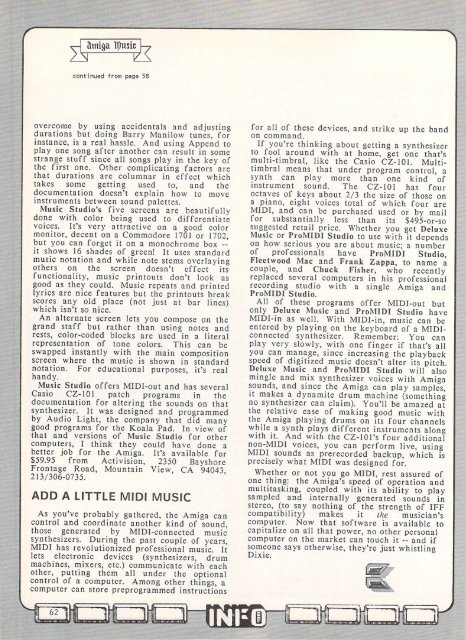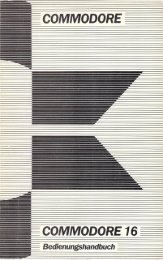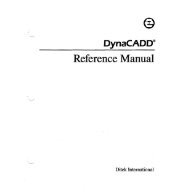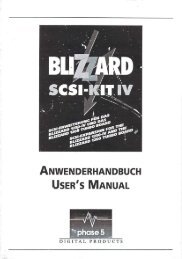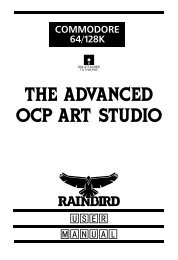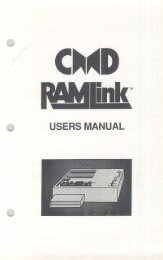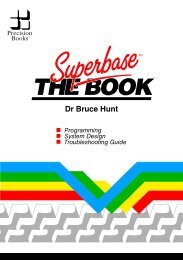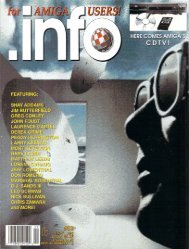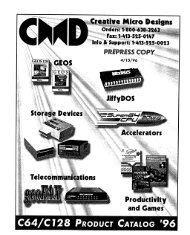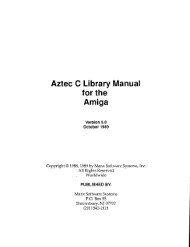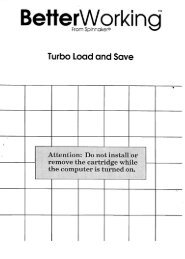You also want an ePaper? Increase the reach of your titles
YUMPU automatically turns print PDFs into web optimized ePapers that Google loves.
Amiga l.pusic<br />
continued from page 58<br />
overcome by using accidentals and adjusting<br />
durations but doing Barry Manilow tunes, for<br />
instance, is a real hassle. And using Append to<br />
play one song after another can result in some<br />
strange stuff since all songs play in the key of<br />
the first one. Other complicating factors are<br />
that durations are columnar in effect which<br />
takes some getting used to, and the<br />
documentation doesn't explain how to move<br />
instruments between sound palettes.<br />
Music Studio's five screens are beautifully<br />
done with color being used to differentiate<br />
voices. It's very attractive on a good color<br />
monitor, decent on a Commodore 1701 or 1702,<br />
but you can f<strong>org</strong>et it on a monochrome box --'<br />
it shows 16 shades of green! It uses standard<br />
music notation and while note stems overlaying<br />
others on the screen doesn't effect its<br />
functionality, music printouts don't look as<br />
good as they could. Music repeats and printed<br />
lyrics are nice features but the printouts break<br />
scores any old place (not just at bar lines)<br />
which isn't so nice.<br />
An alternate screen lets you compose on the<br />
grand staff but rather than using notes and<br />
rests, color-coded blocks are used in a literal<br />
representation of tone colors. This can be<br />
swapped instantly with the main composition<br />
screen where the music is shown in standard<br />
notation. For educational purposes, it's real<br />
handy.<br />
Music Studio offers MIDI-out and has several<br />
Casio CZ-101 patch programs in the<br />
documentation for altering the sounds on that<br />
synthesizer. It was designed and programmed<br />
by Audio Light, the company that did many<br />
good programs for the Koala Pad. In view of<br />
that and versions of Music Studio for other<br />
computers, I think they could have done a<br />
better job for the Amiga. It's available for<br />
$59.95 from Activision, 2350 Bayshore<br />
Frontage Road, Mountain View, CA 94043<br />
213/306-0735.<br />
ADD A LITTLE MIDI MUSIC<br />
As you've probably gathered, the Amiga can<br />
control and coordinate another kind of sound,<br />
those generated by MIDI-connectcd music<br />
synthesizers. During the past couple of years,<br />
MIDI has revolutionized professional music. It<br />
lets electronic devices (synthesizers, drum<br />
machines, mixers, etc.) communicate with each<br />
other, putting them all under the optional<br />
control of a computer. Among other things, a<br />
computer can store preprogrammed instructions<br />
62<br />
innnnii-mmm y UOiLnuaululmiflL<br />
for all of these devices, and strike up the band<br />
on command.<br />
If you're thinking about getting a synthesizer<br />
to fool around with at home, get one that's<br />
multi-timbral, like the Casio CZ-101. Multitimbral<br />
means that under program control, a<br />
synth can play more than one kind of<br />
instrument sound. The CZ-101 has four<br />
octaves of keys about 2/3 the size of those on<br />
a piano, eight voices total of which four are<br />
MIDI, and can be purchased used or by mail<br />
for substantially less than its $495-or-so<br />
suggested retail price. Whether you get Deluxe<br />
Music or ProMIDI Studio to use with it depends<br />
on how serious you arc about music; a number<br />
of professionals have ProMIDI Studio,<br />
Fleetwood Mac and Frank Zappa, to name a<br />
couple, and Chuck Fisher, who recently<br />
replaced several computers in his professional<br />
recording studio with a single Amiga and<br />
ProMIDI Studio.<br />
All of these programs offer MIDI-out but<br />
only Deluxe Music and ProMIDI Studio have<br />
MIDI-in as well. With MIDI-in, music can be<br />
entered by playing on the keyboard of a MIDIconnected<br />
synthesizer. Remember: You can<br />
play very slowly, with one finger if that's all<br />
you can manage, since increasing the playback<br />
speed of digitized music doesn't alter its pitch<br />
Deluxe Music and ProMIDI Studio will also<br />
mingle and mix synthesizer voices with Amiga<br />
sounds, and since the Amiga can play samples,<br />
it makes a dynamite drum machine (something<br />
no synthesizer can claim). You'll be amazed at<br />
the relative ease of making good music with<br />
the Amiga playing drums on its four channels<br />
while a synth plays different instruments along<br />
with it. And with the CZ-lOTs four additional<br />
non-MIDI voices, you can perform live, using<br />
MIDI sounds as prerecorded backup, which is<br />
precisely what MIDI was designed for.<br />
Whether or not you go MIDI, rest assured of<br />
one thing: the Amiga's speed of operation and<br />
multitasking, coupled with its ability to play<br />
sampled and internally generated sounds in<br />
stereo, (to say nothing of the strength of IFF<br />
compatibility) makes it the musician's<br />
computer. Now that software is available to<br />
capitalize on all that power, no other personal<br />
computer on the market can touch it - and if<br />
someone says otherwise, they're just whistling<br />
Dixie.


